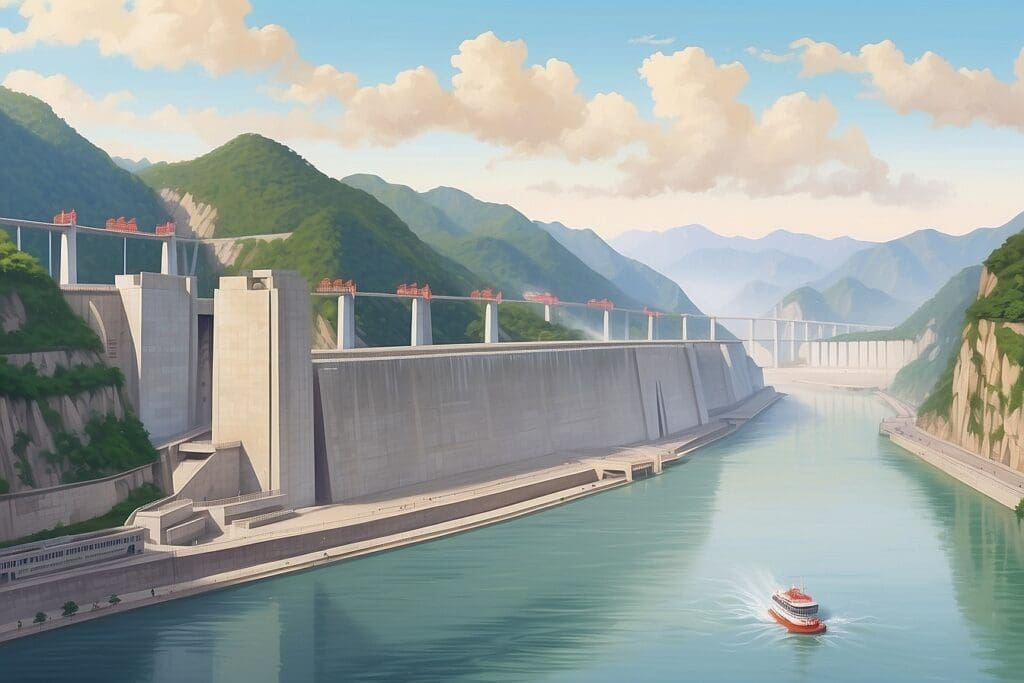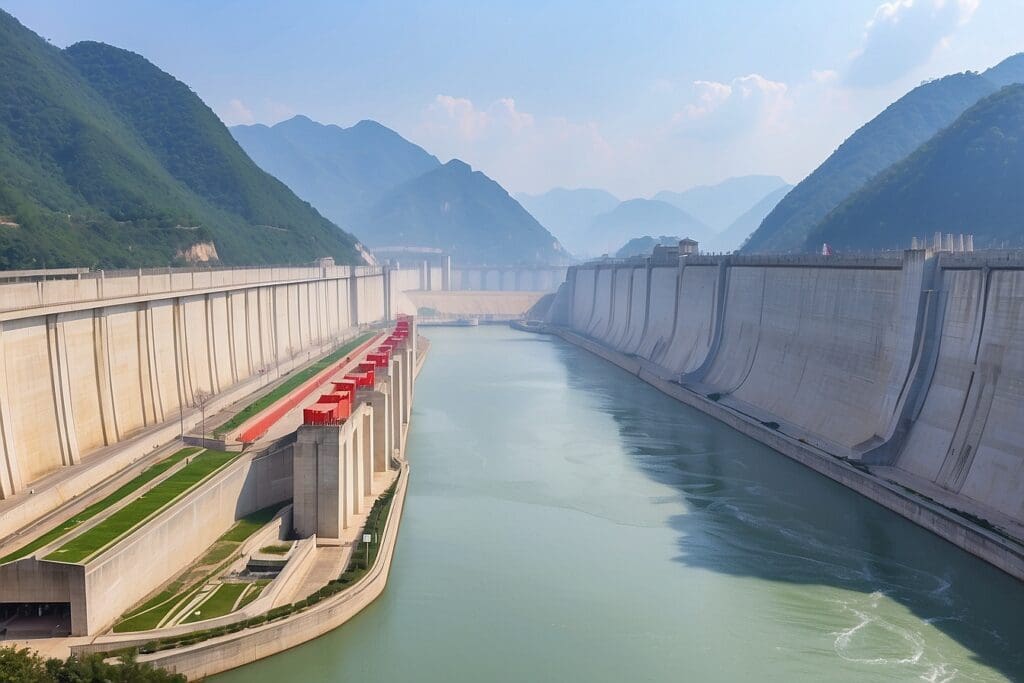In 1919, the founding father of modern China, Sun Yat-sen, had a vision to create a hydroelectric dam at Three Gorges on the Yangtze River. Almost a century later, his idea has finally come to fruition. After 2 decades of construction, the Three Gorges Dam will soon be running as a hydroelectric river dam that spans the Yangtze River in Sandouping, Yiling District, Yichang, Hubei, China. The project’s 26 hydropower turbines are expected to produce at least 18.2 million kilowatts of electricity, up to one-ninth of China’s output, and as much electricity as 18 nuclear power plants.1 Aside from being the largest electricity-generating plant of its kind, the dam also intends to increase the river’s navigation capacity, and reduce the potential for floods downstream by providing flood storage space. Supporters of the dam regard it as a historic social, economic, and engineering success while others view it as a threat to the environment, history, and culture of the region. The subject of controversy remains: are the benefits produced by the Three Gorges Dam worth the consequential impact on the environment and the culture of its region?
The Pros
The Three Gorges Dam’s immediate goal is to provide China with clean, renewable energy, while reducing greenhouse gas emissions. Currently, China relies heavily on coal, a highly polluting fossil fuel, to supply a large percentage of their energy needs. It takes about 366 grams of coal to generate 1 kWh of electricity, and since the dam started generating power over 5 years ago, its total power production is equivalent to 84 million tonnes of standard coal. Overall, the Dam aims to reduce the coal consumption by 31 million tonnes per year, also cutting the atmospheric emission of 100 million tonnes of greenhouse gas, millions of tonnes of dust, one million tonnes of sulfur dioxide, 370,000 tonnes of nitric oxide, 10,000 tonnes of carbon monoxide, and a significant amount of mercury.2 The reduction in fossil fuel consumption will also reduce the carbon footprint of supplying 31 million tons of coal to other regions of China.
Although clean energy is a high priority, the Dam also intends to benefit the environment by providing alternative navigation routes. The Dam has increased the freight capacity on the Yangtze, allowing more goods to be shipped throughout China without the demand for highway transport fuel. From 2004 to 2007 a total of 198 million tonnes of goods passed through the Three Gorges Dam ship locks, significantly reducing carbon emissions from the alternative highway transport.3
According to supporters of the Three Gorges Dam, the most significant benefit is its flood control and drought relief capabilities. The banks of the Yangtze River are home to millions of people, several large cities, thriving agricultural land, important industrial areas, and also major flood zones. Over the past century, the areas down river from the Dam have experienced several major devastating floods. The reservoir flood storing capacity of the Dam will reduce the frequency of major downstream flooding from once every ten years to once every 100 years.4 It will also discharge its reservoir during the dry season to provide more fresh water for agricultural and industrial usage and improve the river’s navigation ability.
The Cons

Although its supporters view the Three Gorges Dam as an environmental success, others believe it could be an environmental catastrophe. In particular, the Dam has put many different ecosystems under stress. According to International Rivers, “It has interrupted fish migration and altered the river’s chemical balance, temperature, and velocity. The mighty river has been turned into a stagnant pool with a limited ability to clean itself, and local boat owners are fishing garbage off the surface.”5 The Dam has driven many species to be endangered or extinct, including the Chinese river dolphin, Chinese sturgeon, river sturgeon, Chinese paddlefish, and the migrating Siberian Crane. The Dam is also decreasing the river’s flushing capacity, causing an increase in pollution and garbage and frequent algae blooms.
Aside from its effect on wildlife, the Dam has also displaced millions of people and caused a serious risk for erosion and landslides. The Three Gorges Dam is the world’s largest resettlement project, displacing over 1 million people, submerging 13 cities, 140 towns, and 1,350 villages. Many of these people have lost their jobs, and farmers are running out of arable land due to erosion. An additional 530,000 people are expected to be relocated by 2020 to relieve pressure on the riverbank slopes. The area is at high risk for erosion and landslides because every year the reservoir level fluctuates between 145 and 175 meters, causing the land to become very fragile and possibly collapse. Moreover, the Yangtze carries 500 million tons of silt into the reservoir every year, and most of it stays trapped there, causing depletion in silt levels downstream. The lack of sediment at the mouth of the river is leading to the erosion of about four square kilometers of coastal wetlands every year, and increasing the levels of seawater in the river. The polluted Yangtze is destroying arable land and threatening drinking water supplies.6 The Dam also lies on a couple major fault lines, and could possibly contribute to seismic risks in the future.
Is it worth it?
The long-term environmental consequences of the Three Gorges Dam are yet to be seen, however, China is currently receiving a significant amount of “arguably” clean hydropower energy. China plans to replicate the model of the Three Gorges Dam, as hydropower proposals have been put forward for the Lancang (Upper Mekong) and Nu (Salween) Rivers.7 Many skeptics believe a thorough evaluation and assessment of the Three Gorges Dam’s overall impact must be made before more mega-dams are considered. Others believe that China should move forward with other forms of renewable energy. As noted by International Rivers, “In recent years, China has renewed its efforts to improve energy efficiency. The country is on track to improve its energy intensity by 20% under the current Five-Year Plan (2006-2010). Its Renewable Energy Law has also set the world’s most aggressive, legally binding target. By 2020, 15% of all energy – or 137,000 MW – is to come from wind, biomass, solar and small hydropower projects.”8 Whether or not the Three Gorges Dam proves to be an environmental success throughout China’s history, the nation itself should be applauded for making their economy more energy efficient.


